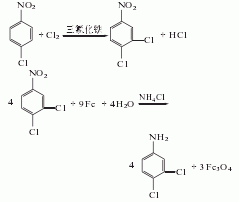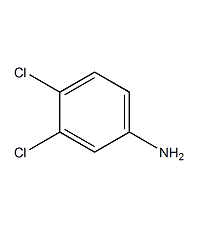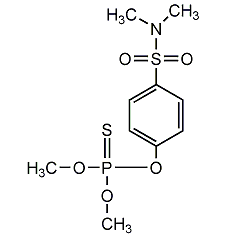Structural formula
| Business number | 029V |
|---|---|
| Molecular formula | C7H8ClN |
| Molecular weight | 141.60 |
| label |
2-amino-4-chlorotoluene, 4-Chloro-2-aminotoluene, 5-Chloro-2-methylaniline, 5-Chloro-o-toluidine, 2-Amino-4-chlorotoluene, 5-Chloro-o-toluidine, ClC6H3(CH3)NH2 |
Numbering system
CAS number:95-79-4
MDL number:MFCD00007779
EINECS number:202-452-6
RTECS number:XU5075000
BRN number:878504
PubChem number:24892755
Physical property data
1. Properties: Brown flaky crystals with pungent odor.
2. Density (g/mL, 20℃): 0.973
3. Relative vapor density (g/mL, air=1): Undetermined
4. Melting point (ºC): 26
5. Boiling point (ºC, normal pressure): Undetermined
6. Boiling point (ºC, 96.2kPa): 237
7. Refractive index: 1.584
8. Flash point (ºC): 160
9. Specific rotation (º): Undetermined
10. Autoignition point or ignition temperature (ºC): Undetermined
11. Vapor pressure (mmHg, ºC): Undetermined
12. Saturated vapor pressure (kPa, 237ºC) : 96.2
13. Heat of combustion (KJ/mol): Undetermined
14. Critical temperature (ºC): Undetermined
15. Critical pressure ( KPa): Undetermined
16. Log value of oil-water (octanol/water) partition coefficient: Undetermined
17. Explosion upper limit (%, V/V): Undetermined
18. Lower explosion limit (%, V/V): Undetermined
19. Solubility: Soluble in hot ethanol.
Toxicological data
1. Acute toxicity: rat oral LD50: 464mg/kg; dog oral LDLo: >100mg/kg; mammal oral LDLo: >200mg/kg;
2. Chronic toxicity /Carcinogenicity
Oral TDLo in rats: 164mg/kg/78W-C; Oral TDLo in mice: 131mg/kg/78W-C; Oral TDLo in mice: 262mg/kg/78W- C;
3. Mutagenicity
Oral gene mutation in mice: 50mg/kg;
Oral DNA inhibition in mice: 200mg/ kg;
Ecological data
This substance is slightly hazardous to water.
Molecular structure data
1. Molar refractive index: 40.20
2. Molar volume (cm3/mol): 119.9
3. Isotonic specific volume (90.2K ): 306.6
4. Surface tension (dyne/cm): 42.7
5. Polarizability (10-24cm3): 15.94
Compute chemical data
1. Reference value for hydrophobic parameter calculation (XlogP):None
2. Number of hydrogen bond donors: 1
3. Number of hydrogen bond acceptors: 1
4. Number of rotatable chemical bonds: 0
5. Number of tautomers: None
6. Topological molecule polar surface area 26
7. Number of heavy atoms: 9
8. Surface charge: 0
9. Complexity: 94.9
10. Number of isotope atoms: 0
11. Determine the number of atomic stereocenters :0
12. Uncertain number of stereocenters of atoms: 0
13. Determined number of stereocenters of chemical bonds: 0
14. Uncertain number of stereocenters of chemical bonds Number of structural centers: 0
15. Number of covalent bond units: 1
Properties and stability
Avoid contact with acids, acid chlorides, acid anhydrides, chloroform, and strong oxidants.
Storage method
Store in a cool, ventilated warehouse. Keep away from fire and heat sources. They should be stored separately from oxidants, acids, and food chemicals, and avoid mixed storage. Equipped with the appropriate variety and quantity of fire equipment. Suitable materials should be available in the storage area to contain spills.
Synthesis method
It is produced by chlorination and reduction of o-nitrotoluene.
Purpose
Used in organic synthesis.
extended-reading:https://www.newtopchem.com/archives/45205extended-reading:https://www.bdmaee.net/niax-k-zero-3000-trimer-catalyst-momentive/extended-reading:https://www.morpholine.org/category/morpholine/extended-reading:https://www.bdmaee.net/wp-content/uploads/2022/08/31-15.jpgextended-reading:https://www.newtopchem.com/archives/44166extended-reading:https://www.bdmaee.net/dibutyl-tin-oxide-food-grade/extended-reading:https://www.cyclohexylamine.net/polyurethane-trimer-catalyst-pt304-dabco-rigid-foam-trimer-catalyst/extended-reading:https://www.newtopchem.com/archives/category/products/page/152extended-reading:https://www.bdmaee.net/dabco-ne1070-polyurethane-gel-type-catalyst-dabco-low-odor-catalyst/extended-reading:https://www.bdmaee.net/cas-683-18-1-2/


















